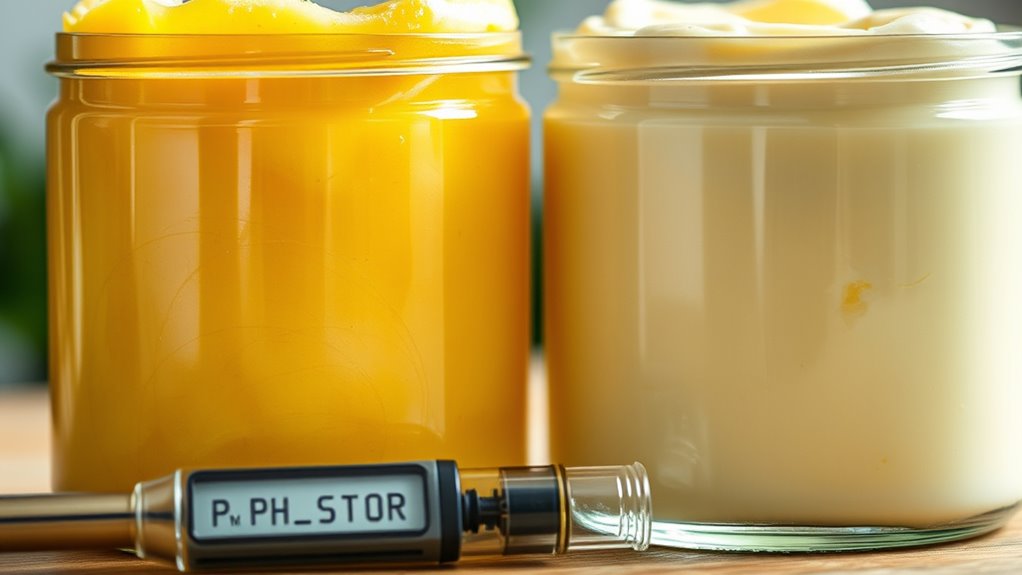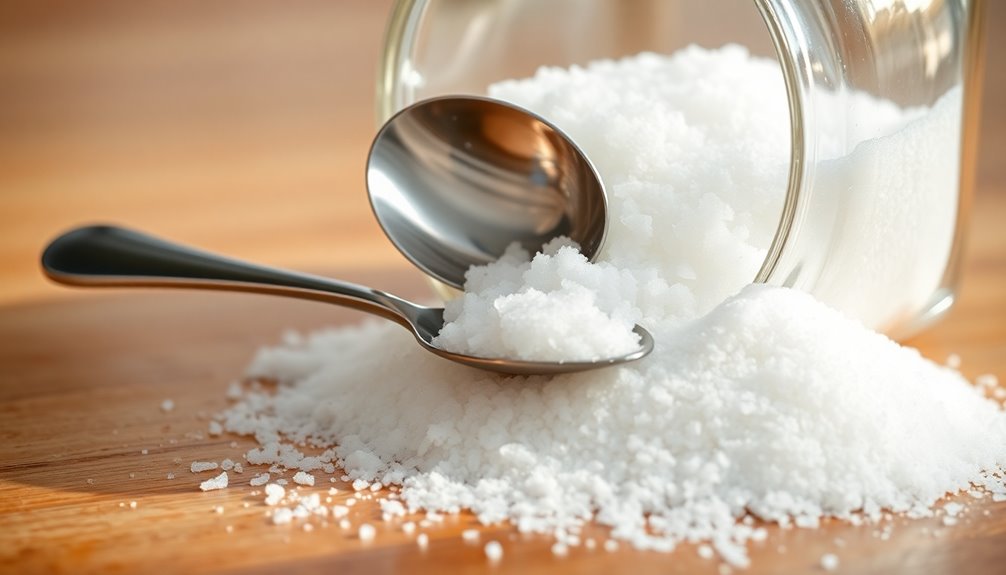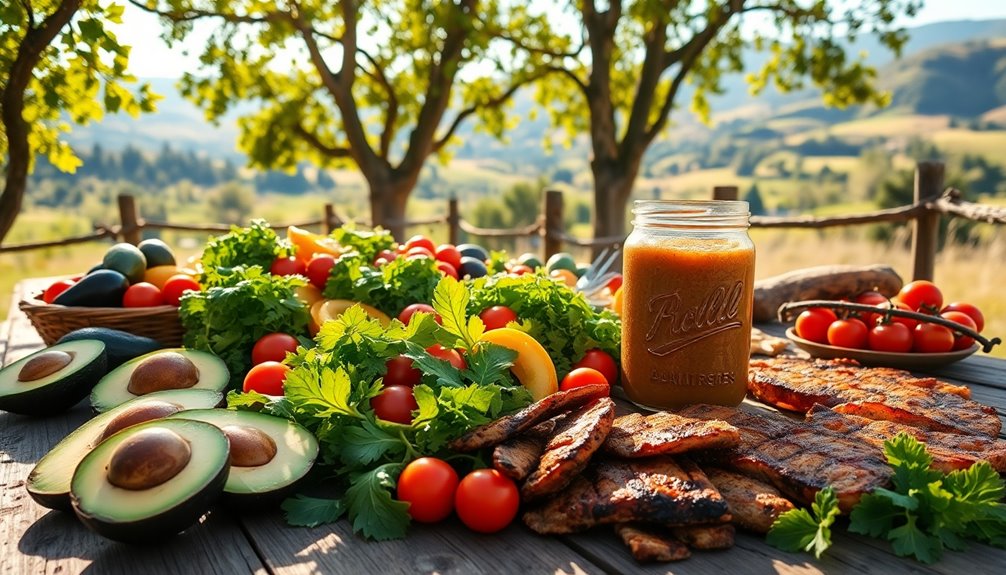Fermented butter has higher butyric acid levels because microbial activity during fermentation creates this compound, giving the butter a richer, tangier flavor and aroma. In contrast, sweet-cream butter, made without fermentation, contains lower butyric acid, resulting in a milder taste and aroma. These differences influence not only flavor but also nutritional qualities. If you’re curious about how these processes impact butyric acid content, you’ll find more details that clarify these variations further.
Key Takeaways
- Fermented butter generally has higher butyric acid levels due to microbial fermentation processes.
- Sweet-cream butter typically contains lower butyric acid, resulting in a milder flavor profile.
- The fermentation process synthesizes butyric acid, adding pungency and complex aroma to fermented butter.
- Storage conditions and microbial activity influence butyric acid content in both butter types.
- The difference in butyric acid levels significantly impacts aroma, flavor, and perceived richness of the butter.
The Production Processes of Fermented and Sweet-Cream Butter
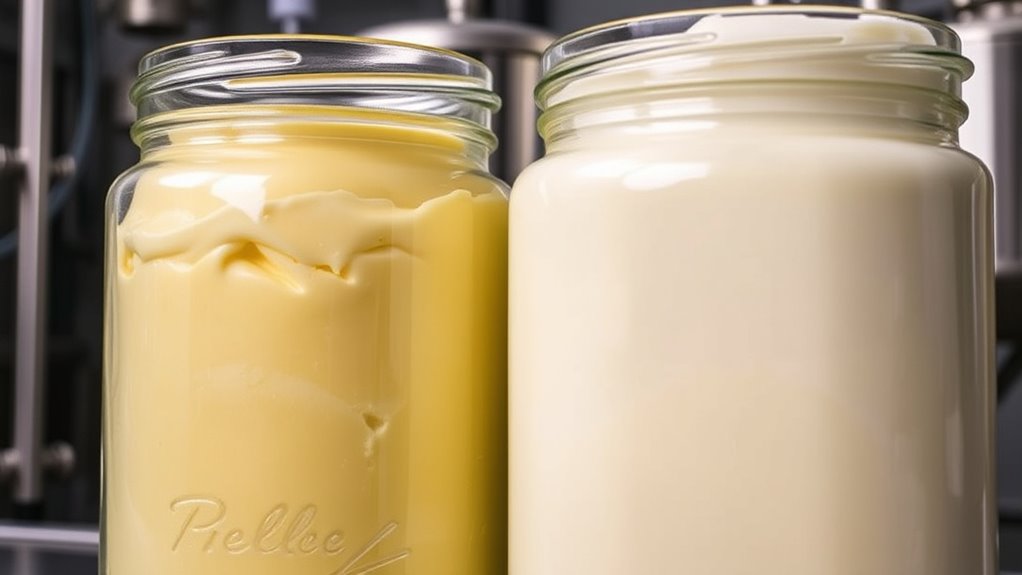
To understand how fermented and sweet-cream butter differ in butyric acid levels, it is vital to examine their production processes. Fermented butter begins with cream that undergoes fermentation, often involving natural or controlled bacteria, which develop flavor and acidity. In contrast, sweet-cream butter is made from fresh, pasteurized cream without fermentation, resulting in a milder taste. Some producers may add artificial additives to enhance shelf life or flavor, but traditional methods avoid these. Packaging methods also vary; fermented butter is often stored in containers that support fermentation and flavor development, whereas sweet-cream butter typically uses airtight packaging to preserve freshness. These production differences directly influence the butter’s chemical makeup and its subsequent butyric acid content.
Chemical Composition and Flavor Profile of Fermented Butter

Have you ever wondered what sets fermented butter’s chemical makeup and flavor apart from other types? The key lies in microbial influence, which transforms its composition during fermentation. Beneficial bacteria break down fats and proteins, producing unique compounds like butyric acid that contribute to its distinctive aroma and tangy taste. Storage effects also play a role; prolonged aging allows microbes to develop complex flavor profiles, intensifying the butter’s richness. These biological processes result in a complex chemical composition that differs markedly from sweet-cream butter. The microbial activity creates a deeper, more nuanced flavor profile, with increased acidity and aromatic complexity. Additionally, the fermentation process involves specific cultural practices, which can influence the microbial diversity and, consequently, the final flavor. Understanding these factors helps explain why fermented butter offers a distinctive sensory experience rooted in its unique chemical and microbial dynamics.
Chemical Composition and Flavor Profile of Sweet-Cream Butter

Sweet-cream butter primarily derives its characteristic flavor and composition from fresh cream that has been churned without extensive fermentation. Because it skips the dairy fermentation process, it retains a clean, mild butter flavor dominated by natural milk sugars, proteins, and fats. Its chemical profile features higher levels of lactic acid and specific volatile compounds that give it a fresh, creamy aroma. Unlike fermented butter, it lacks the tangy notes produced by microbial activity, resulting in a smoother, more delicate flavor profile. The absence of fermentation means fewer butyric acid levels, which influences aroma and taste. Overall, sweet-cream butter offers a pure, straightforward dairy profile that emphasizes the natural sweetness and richness of fresh cream, appealing to those seeking a mild, clean butter flavor. Additionally, the lack of fermentation results in a significantly lower butyric acid content, which further contributes to its milder aroma and taste.
The Role of Butyric Acid in Butter’s Aroma and Taste

Butyric acid plays a key role in shaping butter’s distinctive aroma and flavor, making it a vital component to understand. Its presence influences how we perceive the richness and pungency of the butter, especially during fermentation. By examining how fermentation affects butyric acid levels, you can better appreciate the subtle nuances that define butter’s taste profile. Monitoring credit card statements can also help ensure that your financial transactions remain secure while exploring different types of butter products.
Flavor Profile Significance
Butyric acid plays a crucial role in defining butter’s unique aroma and flavor, as it contributes a distinctive note that many consumers associate with freshness and richness. This compound’s presence influences how butter’s flavor profile is perceived, making it a key factor in natural versus artificially flavored products. While some manufacturers may use artificial flavoring to mimic traditional butter, the authentic butyric acid content provides a genuine taste experience that aligns with consumer preferences for natural, high-quality products. Understanding the significance of butyric acid helps you appreciate the subtle differences in butter’s aroma and taste. Additionally, the color accuracy of a butter sample can influence how its freshness and quality are perceived visually, further affecting consumer preferences. Ultimately, this compound’s level can shape consumer perceptions, guiding choices toward products that deliver the authentic, rich flavor they desire.
Fermentation Impact on Aroma
Have you ever wondered how fermentation influences butter’s aroma and flavor? It’s all about fermentation aroma and butyric acid synthesis. During fermentation, microbes produce butyric acid, which profoundly impacts the butter’s scent and taste. This process enhances the aroma by creating rich, cheesy, and tangy notes. Here’s how it works:
- Microbial activity initiates butyric acid synthesis, releasing compounds responsible for characteristic fermentation aroma.
- The level of butyric acid directly affects the intensity of these aroma notes.
- Variations in fermentation conditions can amplify or diminish the buttery and cheesy flavors associated with butyric acid.
- Fermentation process plays a crucial role in determining the final sensory profile of the butter.
Understanding this process helps you see how fermentation shapes butter’s sensory profile, making it distinct from sweet‑cream varieties.
Comparing Butyric Acid Concentrations in Different Butter Types
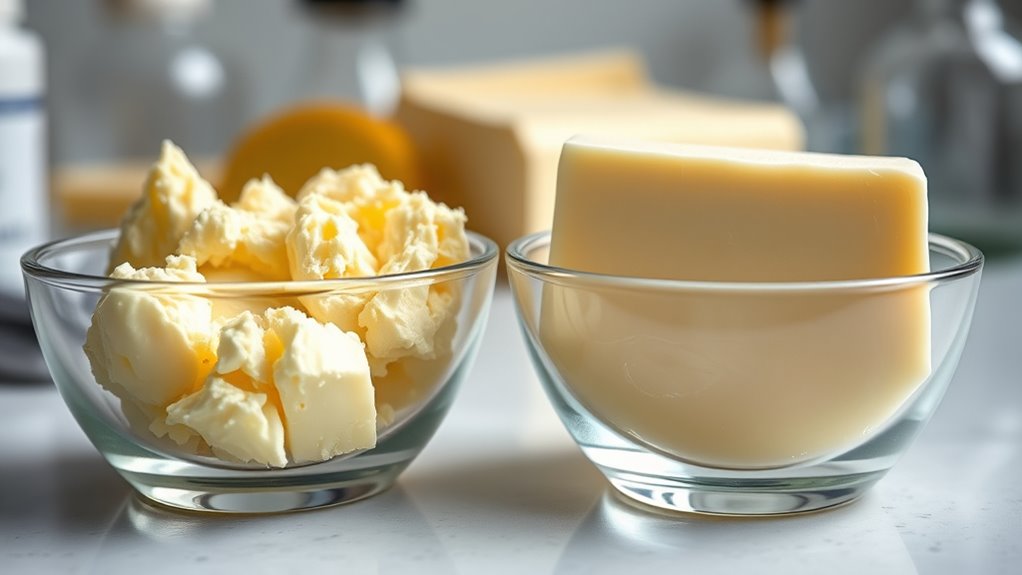
When comparing different types of butter, it’s important to contemplate their butyric acid concentrations, as these levels influence flavor and potential health benefits. Fermented butters typically contain higher butyric acid levels, which can enhance digestive health and support gut integrity through the butyric acid health benefits. In contrast, sweet-cream butter generally has lower concentrations. Understanding these differences helps you appreciate how butyric acid preservation techniques impact butter quality and health value. Higher butyric acid levels are often linked to improved preservation, as they can inhibit spoilage bacteria. When selecting butter, consider how the production process affects butyric acid content, as this directly influences both flavor profile and nutritional benefits. Additionally, being aware of credit card security measures can help consumers make safer online transactions when purchasing specialty butters or ingredients. Ultimately, choosing a butter type with suitable butyric acid levels can enrich your diet and culinary experience.
Factors Influencing Butyric Acid Levels During Production

Several production factors directly influence butyric acid levels in butter, shaping its flavor, quality, and health properties. During dairy fermentation, microbial activity affects butyric acid production, so controlling fermentation conditions is key. Additionally, butter maturation impacts acid levels, as longer aging allows for greater flavor development. To influence butyric acid content, consider these factors:
- Fermentation duration and temperature – Longer, warmer fermentation increases microbial activity, boosting butyric acid levels.
- Microbial cultures used – Specific bacteria in dairy fermentation can enhance or suppress butyric acid formation.
- Handling and storage – Proper butter maturation and storage conditions prevent unwanted microbial activity, maintaining consistent butyric acid levels.
- Growing conditions such as soil health and cultivation practices also play a role in the overall quality of the raw materials used in dairy production.
Implications for Consumers and Producers Based on Butyric Acid Content

Variations in butyric acid levels during butter production directly impact both consumer experience and producer decisions. Higher butyric acid content can enhance the nutritional benefits by promoting gut health and providing a richer flavor profile, aligning with consumer preferences for natural, wholesome foods. As a producer, understanding these implications helps you tailor your processes to meet market demands, whether emphasizing the health benefits of fermented butter or the milder taste of sweet-cream varieties. Consumers increasingly seek products with clear health advantages, so highlighting butyric acid content can boost product appeal. Ultimately, balancing butyric acid levels allows you to optimize both nutritional value and sensory qualities, ensuring your butter meets consumer expectations and supports your brand’s reputation for quality and healthfulness.
Frequently Asked Questions
How Does Storage Duration Affect Butyric Acid Levels in Fermented Butter?
You’ll find that storage duration impacts the storage stability of fermented butter by affecting its acid concentration. Over time, longer storage can lead to increased butyric acid levels, which influences flavor and quality. As you store fermented butter, monitor how acid concentration changes, because these shifts can alter its overall stability. Proper storage conditions help maintain consistent butyric acid levels, ensuring the butter stays fresh and flavorful for longer periods.
Are There Health Benefits Associated With Higher Butyric Acid Concentrations in Butter?
Imagine your gut as a bustling garden, thriving on nourishing elements like butyric acid. Higher levels in butter can boost gut health, acting like a gentle gardener tending to your digestive system. This fatty acid also offers anti-inflammatory properties, helping reduce inflammation and support overall wellness. So, choosing butter rich in butyric acid can be a tasty way to nurture your digestive garden and promote better health.
How Do Regional Production Methods Influence Butyric Acid Content?
Regional fermentation and dairy plant practices substantially influence butyric acid content in butter. If you’re aware of local fermentation methods, you’ll notice they shape the flavor and composition, especially in regions favoring traditional techniques. Dairy plants with specific practices, like controlled aging or fermentation times, can increase or decrease butyric acid levels. So, understanding these regional differences helps you appreciate how production methods impact butter’s nutritional and sensory qualities.
Can Consumers Distinguish Fermented and Sweet-Cream Butter by Flavor Alone?
You might wonder if you can tell fermented from sweet-cream butter just by flavor. With sensory detection, most people can differentiate them because fermented butter often has a tangy, pungent note from butyric acid, while sweet-cream butter tastes milder and creamier. Your palate picks up on these flavor differences naturally, making it possible to distinguish the two types based on flavor alone, especially with some experience or taste testing.
What Are the Environmental Impacts of Producing High Butyric Acid Butter?
Producing high butyric acid butter can have a significant environmental impact, comparable to leaving a giant carbon footprint behind. You should consider how it affects environmental sustainability, as intensive fermentation processes often consume more energy and resources. This results in increased greenhouse gas emissions, which contribute to climate change. To minimize your impact, support eco-friendly production methods that prioritize sustainability and reduce overall carbon footprints.
Conclusion
By understanding how butyric acid varies between fermented and sweet-cream butter, you can appreciate their unique flavors more deeply. Fermented butter’s higher butyric acid levels give it a tangy, robust aroma, while sweet-cream butter offers a milder taste. Knowing this, you can select your preferred butter type based on flavor preference or culinary use. Embrace these differences, and enjoy exploring the rich, complex profiles that each butter brings to your table.
